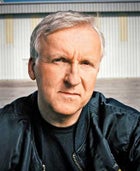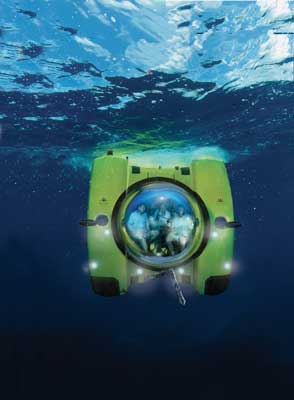It was a perfect spring day to be out on San Francisco Bay, but Chris Welsh, a burly six-foot-three competitive sailor, was cooped up inside a dimly lit workshop, tinkering with a one-man submarine that looked like a boxy glider with stubby wings. The shop, perched above a wharf at Point Richmond, is the home of Hawkes Ocean Technologies. The ship, the Virgin Oceanic, is the result of a collaboration between Welsh (who will pilot the sub), the British engineer Graham Hawkes, and Sir Richard Branson. TheyтАЩve got highтАФor, rather, lowтАФhopes for their project.
Richard Branson (right) with Chris Welsh atop the Virgin Oceanic.
 Richard Branson (right) with Chris Welsh atop the Virgin Oceanic.
Richard Branson (right) with Chris Welsh atop the Virgin Oceanic.Director and explorer James Cameron
 Director and explorer James Cameron
Director and explorer James Cameron╠¤
тАЬItтАЩs not built for speed,тАЭ says Welsh, 48. тАЬItтАЩs built for depth.тАЭ
Specifically, the Virgin Oceanic is designed to reach 36,000 feetтАФthe bottom of the ocean. And Welsh isnтАЩt alone in his quest.
This summer, three crews are on separate missions to build the next big thing in ocean exploration: a manned submarine that can scoot around the Mariana Trench, the deepest place on the planet. In addition to WelshтАЩs Virgin team, Avatar director James Cameron is financing a sub, and Florida-based Triton Submarines is trying to produce a commercial model, the Triton 36,000, that can take clients to earthтАЩs final frontier for as much as $250,000 a head.
A crew has been to the trench before, but not since 1960. ThatтАЩs when Swiss oceanographer and engineer Jacques Piccard, along with 28-year-old U.S. Navy lieutenant Don Walsh, piloted a homemade, 150-ton steel bubble called the Trieste to the floor of the trench. Maybe itтАЩs because heтАЩs the only man alive today whoтАЩs been there, but Walsh, now 79 and the honorary president of the Manhattan-based Explorers Club, doesnтАЩt see the point. тАЬUsually, if thereтАЩs a race, it implies some kind of prize,тАЭ he says dismissively. тАЬWhatтАЩs anyone going to win, the right to be second?тАЭ
But there are broader implications here. These new submarines are as different from the Trieste as a stealth fighter is from a hot-air balloon. The Trieste operated in the manner of most deep-sea submersibles: loaded with weights that were later jettisoned and equipped with flotation devices, it traveled mainly in two directionsтАФdown and then up. Though it had thrusters that allowed for horizontal movement, Walsh and Piccard spent their 20 minutes at the bottom in one spot, surrounded by their own silt cloud, before surfacing with a cracked viewing window. The next generation of explorers hopes to have a look around.
While no single technological breakthrough is rekindling our interest in exploring the Mariana Trench, a series of incremental advancesтАФincluding pressure-resistant syntactic foam, lightweight lithium batteries, and advanced ceramic viewing portsтАФhave led all three groups to the same conclusion: weтАЩre on the cusp of designing subs that can make regular trips to the depths.
ThatтАЩs provided everything goes according to plan. Even the slightest engineering mishap could have dire consequences under deepwater pressures reaching 16,000 pounds per square inch. During ┬нlaboratory testing, for example, the Virgin OceanicтАЩs borosilicate viewing bubble cracked under just 2,200 psi. Hawkes thinks heтАЩs fixed that problem, which he traced to the shipтАЩs joints shrinking at different rates. Still, a malfunction like that at the bottom of the ocean could mean instant death for anyone inside.
One man who intends to take that risk is James Cameron.
тАЬI plan to personally pilot the sub on ┬нevery other dive,тАЭ Cameron told ╣·▓·│╘╣╧║┌┴╧ in an e-mail. тАЬWeтАЩll have multiple 3-D hi-def cameras, a huge lighting array тАж a manipulator arm to take up to 55 pounds of samples, and weтАЩll be carrying a small ROV, like the ones we used to explore the Titanic and Bismarck, which can fly off the sub.тАЭ
The third group in the hunt, a private Florida-based company called Triton, isnтАЩt run by anybody youтАЩve heard of. But founder Bruce Jones, a 55-year-old entrepreneur, hopes to capitalize on the competition with Branson and Cameron. TritonтАЩs marketing materials call it the тАЬrace to inner space!тАЭ
So whoтАЩs going to get there first? тАЬDefinitely Chris Welsh and the Branson team,тАЭ Cameron readily concedes. Welsh and company plan to water-test the roughly $10 million Virgin Oceanic over the summer. The first dive could happen as soon as August.
Hawkes, 63, began working on the sub, originally called the Challenger, in 2003. As ╣·▓·│╘╣╧║┌┴╧ reported last year (see тАЬJust DonтАЩt Call It a Submarine,тАЭ May 2010), adventurer Steve Fossett had commissioned the vehicle to make a dive to the trench, but Fossett died in a 2007 private-plane crash before his dream could be realized. Two years ago, Welsh, who made his money in real estate, was told about the sub while visiting FossettтАЩs estate to purchase his 125-foot racing catamaran, Cheyenne. After buying both crafts, he partnered with Hawkes and Branson to ease the expense of seeing the sub through to completion. Now the upgraded Virgin Oceanic is poised to make dives to the deepest ocean trenches in the worldтАФlaunched from the deck of the Cheyenne.
Triton has a different goal. CEO Jones envisions a practical, comfortable craft that will plunge a pilot and two passengers to the bottom of the ocean at a stomach-dropping 300 feet per minute. The Triton 36,000, which the company plans to produce and sell for roughly $15 million each, is essentially a seven-foot-wide hollowed-out marble. According to Bill Raggio, the chief technical officer of the glass company Rayotek, which designed TritonтАЩs hull, glass spheres strengthen rather than buckle under pressure, and, of course, they offer a better view.
But thereтАЩs a hitch: TritonтАЩs sub hasnтАЩt been built yet. тАЬWeтАЩre talking to a number of first clients because, quite frankly, we donтАЩt have the money to build one of these on spec,тАЭ says Jones, adding that he thinks theyтАЩre more than a year away from a first dive.
The big unknown in the race is actually Cameron, who has been relatively quiet about his plans until now. His sub project began in 2003 with a few sketches but didnтАЩt gain momentum until 2005. ThatтАЩs when Cameron made one of his visits to the Titanic, 12,500 feet down in the North Atlantic, with Ronnie Allum, the Australian engineer whoтАЩs now heading CameronтАЩs Deep Challenge team. (Cameron has yet to release the name of his sub.)
The Deep Challenge project is reportedly well under way, and the subтАЩs cockpit was recently pressure-tested to 16,000 psi at a Penn State University lab. тАЬIt passed with flying colors,тАЭ Cameron says. тАЬThe hull was behaving exactly as designed.тАЭ The sub is now in the final assembly stage, with more than two dozen people working on it. Sea trials are set for next April.
Cameron says that any footage he captures will be completely divorced from his feature films. тАЬHowever, if I see a really alien-looking animal,тАЭ he writes, тАЬsomething that looks very much like it … may end up in future Avatar films.тАЭ Cameron is no celebrity dabbler: he has a decades-long track record of scientific exploration that includes the documentary films Aliens of the Deep and Ghosts of the Abyss. Among other research goals, he hopes the Deep Challenge sub can visit the deep-ocean fault line that caused the recent tsunami in Japan. тАЬOur role is to explore, to image, and to bring back science,тАЭ he writes, тАЬnot to set records.тАЭ
When I visited the Hawkes submarine workshop in early May, Welsh said he was тАЬabout two weeksтАЭ away from taking the Virgin Oceanic for a test run. As this story went to press, his team still hadnтАЩt taken the ship down, and he emphasized that they wouldnтАЩt do so prematurely. тАЬWeтАЩre not rolling the dice with our fingers crossed,тАЭ he said.
Cameron doesn't appear to be in a hurry, either. “I am talking to Chris Welsh about ways we can cooperate,” he says. “I'd love to film him flying by 36,000 feet down. How cool would that be?”


